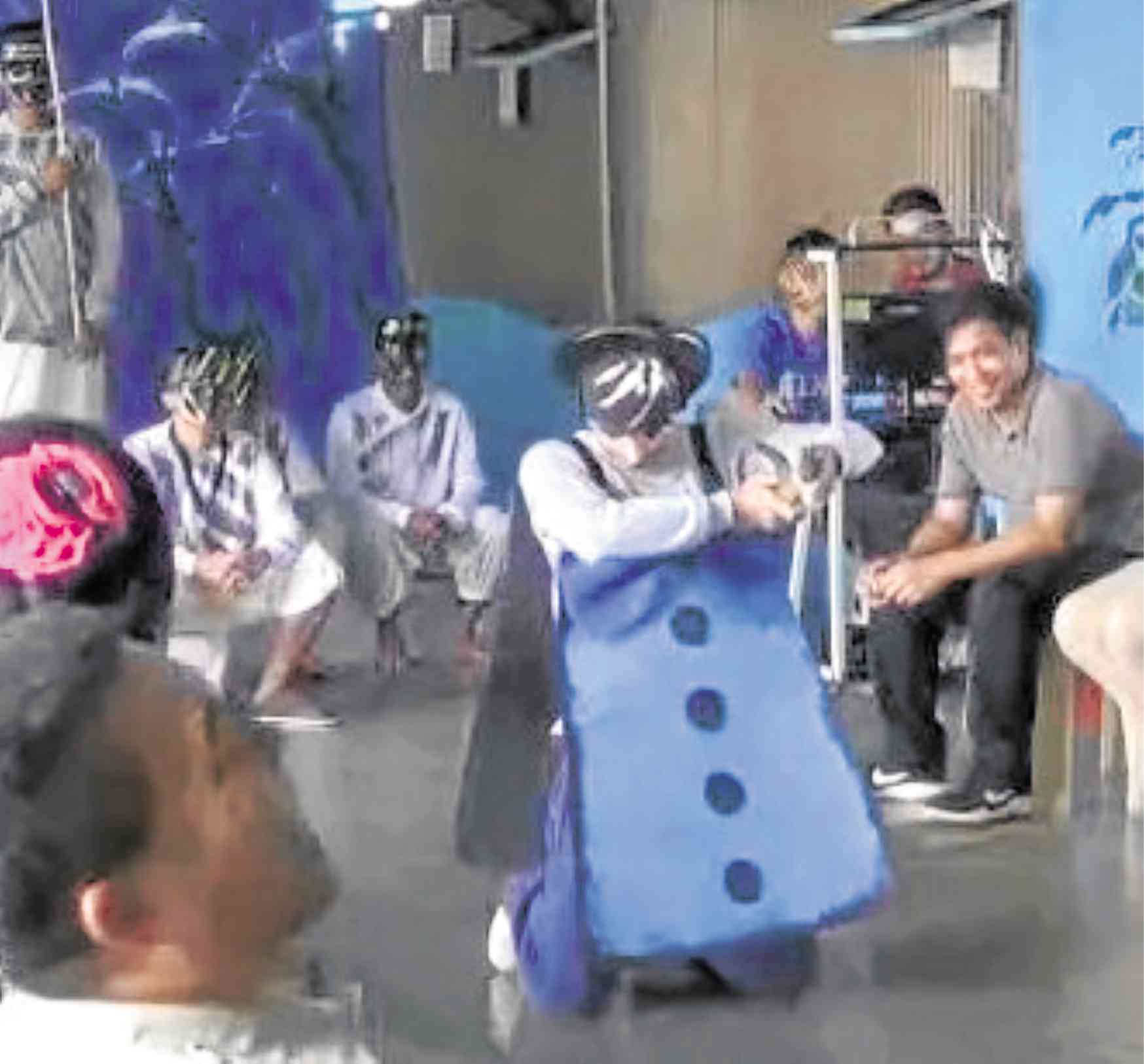
For six Sundays last July and August, three theater artists—Nicolo Magno, Tata Tuviera and, on one occasion, Ateneo Fine Arts visiting professor Ian Maclennan—joined me at Camp Sampaguita, Bilibid Prison, to give a series of workshops that culminated in a staging of a scene from Shakespeare’s “A Midsummer Night’s Dream,” the Pyramus and Thisbe scene, to be precise, in Rolando Tinio’s translation, with songs and dances to add to the merriment.
It was the Camp’s offering for Buwan ng Wika.
Our actors were young men, aged 19-23, serving their sentences in a unit called Special Classes for Children in Conflict with the Law (SC-CCIL), its facilities housed at Camp Sampaguita, also known as the Medium Security Camp, about two kilometers away from the Maximum Security Prison.
Over 70 juveniles, as they are called, populate the SC-CCIL; about 35 agreed to enlist in the theater project. All but one had no theater experience, and the one who did attended a theater workshop in the Camp a few years back.
The choice to do a comedy came from the inmates and the prison staff.
Two years ago, under the direction of Ron Capinding, we staged a devised piece titled “Tumbang Preso,” a dramatic presentation featuring the inmates’ words of retribution and hope, with a completely different cast, many of whom have already been set free in 2018.
With funds from RolePlayers, Inc., a training company, and my Ateneo High School ’62/College ’66 Class, we slowly brought a bit of Shakespeare to life.
Challenges
Challenges, both institutional and human, met us along the way.
We had to secure an entry permit; get approval for whatever stage materials and food we brought in; leave mobile phones, laptops, USBs and other electronic equipment at the gate; forego cigarettes and lighters; and carry no more than P2,000 in our wallets.
Each time, we could rehearse only until 3 p.m. to give inmates time to finish their duties and eat dinner before they returned to a building that was locked at 5 p.m.
We managed working with these constraints, largely with the help of SC-CCIL staff members.
The students themselves posed another set of challenges. Most of the juveniles could neither read nor write. To get around this, we relied on peer support with the literate ones helping the “no read-no write” ones to memorize the lines assigned them.
We also incorporated a lot of dance and movement, drawing on the juveniles’ skill in street dancing, an ability affirmed by their victory in a recent camp-wide cheer dance competition.
Most of the detainees also needed a boost in self-confidence. Perhaps because of their tough socioeconomic backgrounds, their deference to prison authority, and their lack of affirmation from significant others, most of them hesitated to speak up, express themselves, move freely, or improvise early on in the workshops

The exercises Nicolo and I chose, notably mask work, dwelt more on building the imagination, on creatively using the body, on developing awareness of co-actors as preludes to text work.
Discernible improvements in comfort and confidence appeared over time.
We performed at 1 p.m. with no additional lights, and among those who watched the half-hour show were Bureau of Corrections (BuCor) officials, our guests, and inmates from other units of the Camp.
One of our guests, journalist Luz Victoria de Leon, wrote on Facebook:
“What a show… The actors were enthusiastic, lively and thoroughly into Shakespeare’s love story of Piramus & Thisbe. The all-male cast were comically costumed to transport us to a fantasy place of theater. Thank you, Prof. Ricky Abad, Ateneo trainers and Bilibid admin for this encompassing memorable experience.”
After the show, each of the performers was awarded a Certificate of Achievement. They can use this certificate as proof of good behavior when their cases are reviewed for a possible reduction in sentence. It’s a passport to freedom.
Sadly, none of the detainees’ friends or relatives were around to witness this accomplishment. Not surprising, an official revealed, since the juveniles rarely, if ever, received visitors.
Lessons
What we’ve learned is that theater, specifically the bonding or contact that theater generates, makes a difference in transforming the lives of prisoners, or persons deprived of liberty.
Asked what he learned from doing theater, one actor sums up what the others also said: “Kaya ko palang humarap sa maraming tao; ’di ko akalain na magagawa ko iyon, yung magsalita at magpatawa.” (I realize I can face people. I never thought I could do that—speak and make people laugh.)
Another actor added: “Sana makabalik kayo. Ang sarap matutong magsalita ng tama at kumilos sa iba’t-ibang paraan.” (We hope you return. It’s fulfilling to learn how to speak properly and to act.)
Bernardo Lopez, a classmate who first put me in contact with Bilibid, observed similar effects after “Tumbang Preso” two years back. He wrote on the Ateneo website:
After the resounding curtain call, the cast was asked to say something. Everyone eagerly raised their hands. The transformation was awesome. From extreme shyness, they were suddenly talking with pride and confidence. Many had a common message—that they were surprised with themselves that they could talk in front of an audience with candor, something they had never done before… Now they were proud of and believed in themselves.
The literature on prison theater affirms these self-discoveries. Theater engagement gives inmates a perspective on their lives, an opportunity to develop skills in self-expression, in handling emotions, and in working with others.
Some studies even show that participants in prison theater are less likely to return to prison after release.
Officials of the Bureau of Corrections, notably Supt. Carmencita Bravo and Acting SC-CCIL Director Christian Cruz, have witnessed these transformations. Both are convinced of the power of theater to reform and rehabilitate juveniles. They seek to lessen the stigma associated with being a prisoner by having the juveniles perform for the larger public.
Arrangements are being made to have the detainees perform at the Ateneo late this year. “Sana matuloy ito” (We hope this pushes through), said one inmate, “para malasahan man lang, kahit ilang oras man lang, ang lasa ng kalayaan.” (So that we get a taste of freedom, albeit briefly.)
After the show, as the juveniles packed their costumes backstage, an inmate sat alone in one corner, looking at his certificate. I do not know if he knew how to read. But he looked at his certificate a long time, deciphering the words, perhaps imagining it as the diploma he never had.
He had one now, a symbol of what he was able to achieve, and it felt wondrous. He smiled, gazed at the prison gate, and thought, I guess, that he had just taken one step to set himself free.
Many Filipino theater artists have done theater at Bilibid over the years. We continue their work. Together, we offer hope. —CONTRIBUTED








































